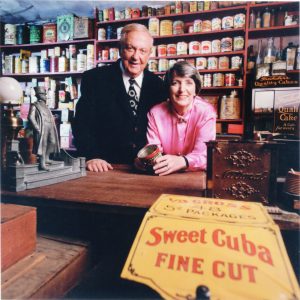Leading antiques expert demystifies collecting from pricing to provenance. Weekly
Two of the world’s leading experts in antiques and collectibles offer up-to-date information, useful advice, and bargain-hunting tips.
 Terry Kovel, along with her late husband, Ralph, pioneered price guides for antiques and collectibles. In the process, she helped create the modern mania for family heirlooms and flea-market finds evidenced in the buy-and-sell phenomenon that is eBay as well as immensely popular television shows such as “Antiques Roadshow,” “Pawn Stars,” “Treasure Hunters” and “American Pickers.”
Terry Kovel, along with her late husband, Ralph, pioneered price guides for antiques and collectibles. In the process, she helped create the modern mania for family heirlooms and flea-market finds evidenced in the buy-and-sell phenomenon that is eBay as well as immensely popular television shows such as “Antiques Roadshow,” “Pawn Stars,” “Treasure Hunters” and “American Pickers.”
Terry and Ralph began writing for the Cleveland Press in 1953 and the column went into national syndication via King Features two years later, making it the longest-running U.S. syndicated column written by the original bylined author. The popular weekly column, called Kovels: Antiques and Collecting, is written primarily for average collectors and history buffs, not museum curators, and is distributed to almost 100 newspapers.
Today, the column continues with daughter Kim Kovel as co-author and offers a two-generation discussion about what’s trending with both traditional and modern collectors. The Q&A column offers invaluable advice on prices, tips on bargain-hunting, care and identification of antiques and other collectibles.
The Kovels have authored more than 100 books that have sold more than 4 million copies, including the essential “Kovels’ Antiques & Collectibles Price Guides,” plus other books on subjects such as silver and American art pottery. The Kovels have also kept collectors and dealers up to date through a monthly newsletter and a robust, interactive website at www.kovels.com.
The Kovels have been featured frequently through the years on radio and television shows, and produced several programs for public television, Discovery Channel and, for HGTV, the program “Flea Market Finds with the Kovels.” The Kovels also wrote articles for various publications, including Forbes Magazines, and contributed the “Art, Antiques & Collections: Collectibles” section for Encyclopedia Britannica. In 2010, Ralph and Terry were inducted into the Cleveland Journalism Hall of Fame by the Press Club of Cleveland.
SAMPLE COLUMN
Danish modern chairs were offered in stores in the U. S. in the early 1950s. The Scandinavian designs were inspired by earlier furniture, the 18th-century English chair, a Chinese Ming dynasty chair, a Japanese director’s chair. Many of the modern chairs were made of hand-carved curved wooden pieces joined with dovetails to make a comfortable back, arms, seat and sides. Teak, oak, rosewood and light-colored woods were used with fabric, leather or caned seats. Hans Wegner of Denmark created his most famous chair in 1949. It is now known as “The Chair.” It was made and sold by Hansen/Knoll company for many years. “The Chairs” were chosen for John F. Kennedy and Richard Nixon in the first-ever presidential televised debate in 1960. One of “The Chairs,” made in about 1969 and featuring a leather seat, the Knoll label and Hansen stamps, sold in 2016 for $610. Later versions of this iconic chair are available in shops and shows today.
***
Q: I bought some Noritake Azalea china at a local estate sale because I thought it was interesting and it was reasonably priced. It’s marked with an “M” in a wreath. There are more than 100 pieces, including service for 12 with one coffee cup missing. I don’t plan to use the dishes. Do you have any suggestions where I can sell them?
A: Noritake porcelain was made in Japan by Nippon Toki Kaisha after 1904. Azalea pattern dinnerware was made by Noritake as premiums for the Larkin Co., a soap manufacturer in Buffalo, N. Y., from about 1915 to 1932. The letter “M” in a wreath was a mark used by Morimura Brothers, a distributor in New York City. Azalea is a popular pattern and sells online on several sites. You also can sell them to a matching service like replacements.com. Sets of china don’t sell well unless they are complete. Retail prices online for single pieces are often high. You will get a third or less of that when selling them.
***
Q: My husband owned an auto-parts store and has just retired. We have several old advertising signs and lots of old car parts still in boxes we need to sell. Who would be interested in items like these?
A: Advertising signs sell well at advertising auctions. There are many auctions that have recently sold advertising items online. There also are online sites that sell auto parts. Antiques shops and flea-market dealers also sell old advertising signs. Car parts are a little harder. You might find a nearby car rally or car show and ask some of the participants. They might be interested in the boxes of parts. You also can advertise them in a local newspaper.
** *
Q: I have a brass tea set that has sat unused for many years. Should I polish it or leave the natural patina?
A: You should polish your brass tea set with a commercial brass polish. If it’s heavily tarnished or corroded, take it to a professional. Some brass has been lacquered to prevent tarnish and should not be polished. Polishing damages the lacquer. If the lacquer is peeling, you should go to a professional restorer.
** *
Q: Should I loan a number of my antiques for a fundraising event? They want me to set up my exhibit and leave it for two weeks. I would like to do it, but I am concerned about security and other problems. What should I worry about? None of the pieces are extremely valuable, but they are among my favorites and some are even family heirloom.
A: There is always a risk when you exhibit your collection. The exhibit should be in a secure building with a 24-hour security guard or electronic system. Security usually is good during a show, but during setup and after show hours, there are people who can get into the room. Before you pack the items, take pictures and list every item with your estimated value. Be sure the value is seen only to estimate insurance needed. Never advertise the value of your collections. Make sure there is a barrier between the exhibit and the public, perhaps shelves behind a large table, or a locked cabinet. Don’t exhibit any posters or prints in a sunny window. The sun will cause damage. Make sure the pieces are not remounted or altered. Decide before the show how the collection will be packed and returned. A non-profit show may be run by people with no idea of the cost of old things. We loan pieces to teach the public about the past and the joys of collecting, but we had a sundrenched poster fade to unreadable, a
clever advertising sign stolen during a show and a figurine come back missing a hand.
** *
Tip: Porcelain and stoneware can be washed, but it is best to hand wash the pieces and not to use the dishwasher.
***
Sign up for our free weekly email, “Kovels Komments.” Terry Kovel writes about the latest news, tips, questions and her views of the market. If you register on our website, kovels.com, there is no charge.
***
Terry Kovel and Kim Kovel answer questions sent to the column. By sending a letter with a question and a picture, you give full permission for use in the column or any other Kovel forum. Names, addresses or email addresses will not be published. We cannot guarantee the return of photographs, but if a stamped envelope is included, we will try. The amount of mail makes personal answers or appraisals impossible. Write to Kovels, (Name of this newspaper), King Features Syndicate, 300 W. 57th St., New York, NY 10019.
* * *
CURRENT PRICES
Current prices are recorded from antiques shows, flea markets, sales and auctions throughout the United States. Prices vary in different locations because of local economic conditions.
Mustache cup, porcelain, white ground, blue flowers, forget-me-nots, gilt stems, loop handle, c. 1910, 2 x 4 inches, $20.
Mechanical postcard, Thanksgiving greeting, opens into booklet, Indian maiden holding turkey, Germany, 1913, $95.
Tin, Thanksgiving, round, orange and black, pilgrim girl holding basket, pumpkins and turkeys, 1920s, 1 3/4 x 3 3/4 inches, $125.
Bread slicer, cast iron, turned wooden handle and slice tray, curved blade, Alexanderwerk, Germany, 1930s, 11 x 15 inches, $160.
Sewing box, tramp art, cigar box wood, notched and layered, pin cushion top, stepped flip lid, panels, block feet, c. 1905, 7 x 11 inches, $290.
Jade carving, crouching panther, stalking prey pose, spinach-green color, wood stand, 1900s, 6 inches, $355.
Silver teapot, carved zodiac symbols, dragon, amber jade rings, curved spout, loop handle, lid, monkey finial, Tibet, 1940s, 15 inches, $485.
Dough box, painted wood, Saint holding a skull, robe, turquoise scroll, rectangular, shaped, c. 1910, 6 x 35 inches, 1,200.
Sideboard, wood, Moroccan design, turquoise paint, oval and diamond panel doors, India, 1940s, 41 x 55 x 19 inches, $1,670.
Bronze censer, bulbous, bat shape handles, openwork lid, bats and clouds design, figural kneeling monkeys tripod base, 14 x 11 inches, $2,965.
***
NEW! Handbag collecting has surged in popularity since 2010 when the first large auctions were introduced. Today purses by brands, like Hermes, are sold for prices over $100,000. Sales, shows, stores and online retailers are selling used vintage handbags. Build your collection while prices of undiscovered brands are low. This report includes Makers information, trademarks, information on fakes, care and 130 color photos for over 75 brands. Plus a free supplement with current prices. Special Report, 8 1/2 x 5 1/2 inches, 46 pp. Available only from Kovels for $19.95 plus $4.95 postage and handling. Order by phone at 800-303-996, online at Kovels.com; or mail to Kovels, Box 22900, Beachwood, OH 44122.
***
(Cutline for Nov. 13, 2016)
“The Chair,” a famous and comfortable chair, sold for $610. It is one of the 200 designs for chairs created by Hans Wegner of Denmark.
(c) 2016 by Cowles Syndicate Inc.
